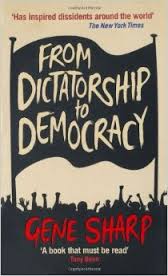

|
|

From Dictatorship to Democracy
Sharp, Gene
http://www.aeinstein.org/organizations/org/FDTD.pdfhttp://www.connexions.org/CxLibrary/Docs/CX13636-Sharp-FromDictatorshipToDemocracy.pdf Publisher: Albert Einstein Institution Year First Published: 2002 Year Published: 2010 Pages: 101pp ISBN: 1-880813-09-2 Resource Type: Pamphlet Cx Number: CX13636 A short, serious introduction to nonviolent struggle, its applications, and strategic thinking. Based on pragmatic arguments, this piece presents nonviolent struggle as a realistic alternative to war and other violence in acute conflicts. It also contains a glossary of important terms and recommendations for further reading. Abstract: - Gene Sharp writes: I have tried to think carefully about the most effective ways in which dictatorships could be successfully disintegrated with the least possible cost in suffering and lives. In this I have drawn on my studies over many years of dictatorships, resistance movements, revolutions, political thought, governmental systems, and especially realistic nonviolent struggle. This publication is the result. Table of Contents Preface One Facing Dictatorships realistically 1 A continuing problem 2 Freedom through violence? 4 Coups, elections, foreign saviors? 5 Facing the hard truth 7 Two The Dangers of negotiations 9 Merits and limitations of negotiations 10 Negotiated surrender? 10 Power and justice in negotiations 12 'Agreeable' dictators 13 What kind of peace? 14 Reasons for hope 14 Three Whence comes the power? 17 The 'Monkey Master' fable 17 Necessary sources of political power 18 Centers of democratic power 21 Four Dictatorships have weaknesses 25 Identifying the Achilles’ heel 25 Weaknesses of dictatorships 26 Attacking weaknesses of dictatorships 27 Five Exercising power 29 The workings of nonviolent struggle 30 Nonviolent weapons and discipline 30 Openness, secrecy, and high standards 33 Shifting power relationships 34 Four mechanisms of change 35 Democratizing effects of political defiance 37 Complexity of nonviolent struggle 38 Six The need for strategic planning 39 Realistic planning 39 Hurdles to planning 40 Four important terms in strategic planning 43 Seven Planning strategy 47 Choice of means 48 Planning for democracy 49 External assistance 50 Formulating a grand strategy 50 Planning campaign strategies 53 Spreading the idea of noncooperation 55 Repression and countermeasures 56 Adhering to the strategic plan 57 Eight Applying political defiance 59 Selective resistance 59 Symbolic challenge 60 Spreading responsibility 61 Aiming at the dictators’ power 62 Shifts in strategy 64 Nine Disintegrating the Dictatorship 67 Escalating freedom 69 Disintegrating the dictatorship 70 Handling success responsibly 71 Ten Groundwork for durable democracy 73 Threats of a new dictatorship 73 Blocking coups 74 Constitution drafting 75 A democratic defense policy 76 A meritorious responsibility 76 Appendix One The methods of nonviolent action 79 Appendix Two Acknowledgements and notes on The story of From Dictatorship to Democracy 87 Appendix Three A note about translations and reprinting of this publication 91 For further reading 93 Subject Headings |